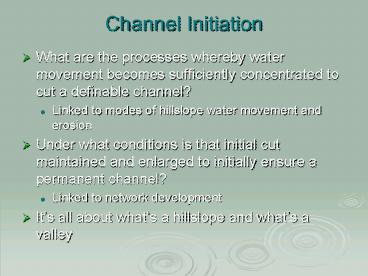Channel Initiation PowerPoint PPT Presentation
1 / 11
Title: Channel Initiation
1
Channel Initiation
- What are the processes whereby water movement
becomes sufficiently concentrated to cut a
definable channel? - Linked to modes of hillslope water movement and
erosion - Under what conditions is that initial cut
maintained and enlarged to initially ensure a
permanent channel? - Linked to network development
- Its all about whats a hillslope and whats a
valley
2
Channel Initiation
- Channel head the upstream limit of concentrated
water flow between banks (Dietrich and Dunne,
1993) - a major boundary between hillslopes and channels
- pivot point in sediment transport between
diffusive process and incisive process - transition to incisive processes from diffusive
processes - an erosional threshold is exceeded enabling
channel-forming processes to become effective - Two views
- topological transition from convex to concave
profile, or divergent to convergent topography - threshold based driving forces (erosion
manifested through high hyd. gradient, high
porewater pressure) exceeds resisting forces
(soil cohesion, vegetation)
3
Mechanisms of Channel Initiation
- Channel initiation requires runoff
- Channel initiation occurs by (driving forces)
- Horton overland flow
- Saturation overland flow
- Subsurface flow
- seepage erosion
- shallow landsliding
- Resisting forces
- Infilling rate, vegetation types, soil cohesion
- Often multiple processes at work
4
Channel Head Location and Topography
Montgomery and Dietrich, 1989
5
Channel Initiation and Basin Morphometry
- Process model for channel initiation by shallow
landsliding - convergent topography causes colluvium eroded
from adjacent hillslopes to accumulate - at critical threshold, landsliding occurs
exposing underlying material - erosion of underlying material by saturation
overland flow initiates channel - Channel heads controlled by hillslope process
rather than network extension - Inverse of source basin length drainage density
6
Networks
- A stream or river network is composed and
characterized by - A set of nodes classified into (a) outlet node,
(b) exterior node, (c) interior node. - Exterior nodes occur in headwater basins.
- Interior nodes include all inner basins with
multiple tributaries. The outlet node is the root
of the network. - A set of links or reaches classified into (a)
interior links or (b) exterior links. - A numbering system to order the stream links
and nodes - Horton (1945) developed a numbering system
- Strahler (1957) improved upon Hortons
classification system
7
Network Ordering
- Channels originating at a source are first order
(headwater) streams - For Horton-Strahler,
- When stream of same order join, add 1 to the
stream order - When stream of different order confluence, assign
highest order - For Shreve,
- When streams of similar order join, add them to
get d/s order
http//www.ees.nmt.edu/vivoni/mst/lectures/Lecture
18.pdf
8
Limitations of Horton-Strahler ordering (Mike
Kirkbys slide)
- Order does not express the intuitive size of a
catchment very well
9
Network Development Deterministic vs.
Probabilistic
- Uniform energy expenditure and minimum energy in
any link of the network were tested with respect
to the development of network topology
Rodriguez-Iturbe and Rinaldo (1992). - They calculated power, P, applying these
conditions, at each link in several hypothetical
networks, and then summed power in all the links - The network that most closely resembles a
natural network had the smallest rate of energy
expenditure shows the tendency towards an optimal
state exists for network topology
P574
P303
Different networks and rate of energy
expenditure, P, for a set of equally spaced
points connected to a common outlet. From
Rodriguez-Iturbe and Rinaldo (1992).
P151
10
Watershed Networks
- Watershed network comprised of
- headwater and network systems
- First and second order streams often comprise 70
of the stream network (Benda et al, 1992) - High ecological value
- Stream networks defined by
- Natl Hydrography Dataset (1100,00)
- Terrain analysis
- (area, area-slope area-length thresholds)
11
Effects of low order channels on downstream
reaches in the network
- Synchronous (or asynchronous) inflows of water,
sediment, nutrients, and organic matter create a
variety of channel conditions and biological
assemblages - Connectivity of headwater systems to downstream
reaches affects the cumulative and dispersed
nature of material transport processes - Gomi, et al, Understanding processes and
downstream linkages of headwater systems,
BioScience, Oct. 2002, vol. 52, no. 10

